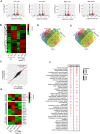The regulatory subunits of CK2 complex mediate DNA damage response and virulence in Candida Glabrata
- PMID: 37891489
- PMCID: PMC10612253
- DOI: 10.1186/s12866-023-03069-4
The regulatory subunits of CK2 complex mediate DNA damage response and virulence in Candida Glabrata
Abstract
Background: Candida glabrata which belongs to normal microbiota, has caused significant concern worldwide due to its high prevalence and drug resistance in recent years. C. glabrata has developed many strategies to evade the clearance of the host immune system, thereby causing persistent infection. Although coping with the induced DNA damage is widely acknowledged to be important, the underlying mechanisms remain unclear.
Results: The present study provides hitherto undocumented evidence of the importance of the regulatory subunits of CgCK2 (CgCkb1 and CgCkb2) in response to DNA damage. Deletion of CgCKB1 or CgCKB2 enhanced cellular apoptosis and DNA breaks and led to cell cycle delay. In addition, deficiencies in survival upon phagocytosis were observed in Δckb1 and Δckb2 strains. Consistently, disruption of CgCKB1 and CgCKB2 attenuated the virulence of C. glabrata in mouse models of invasive candidiasis. Furthermore, global transcriptional profiling analysis revealed that CgCkb1 and CgCkb2 participate in cell cycle resumption and genomic stability.
Conclusions: Overall, our findings suggest that the response to DNA damage stress is crucial for C. glabrata to survive in macrophages, leading to full virulence in vivo. The significance of this work lies in providing a better understanding of pathogenicity in C. glabrata-related candidiasis and expanding ideas for clinical therapies.
Keywords: Candida glabrata; Cell cycle; DNA damage; Macrophage; Virulence.
© 2023. The Author(s).
Conflict of interest statement
The authors declare no competing interests.
Figures








Similar articles
-
Functional genomic analysis of Candida glabrata-macrophage interaction: role of chromatin remodeling in virulence.PLoS Pathog. 2012;8(8):e1002863. doi: 10.1371/journal.ppat.1002863. Epub 2012 Aug 16. PLoS Pathog. 2012. PMID: 22916016 Free PMC article.
-
The Candida glabrata Parent Strain Trap: How Phenotypic Diversity Affects Metabolic Fitness and Host Interactions.Microbiol Spectr. 2023 Feb 14;11(1):e0372422. doi: 10.1128/spectrum.03724-22. Epub 2023 Jan 12. Microbiol Spectr. 2023. PMID: 36633405 Free PMC article.
-
Glyoxylate cycle gene ICL1 is essential for the metabolic flexibility and virulence of Candida glabrata.Sci Rep. 2019 Feb 26;9(1):2843. doi: 10.1038/s41598-019-39117-1. Sci Rep. 2019. PMID: 30808979 Free PMC article.
-
DNA damage response of major fungal pathogen Candida glabrata offers clues to explain its genetic diversity.Curr Genet. 2021 Jun;67(3):439-445. doi: 10.1007/s00294-021-01162-7. Epub 2021 Feb 23. Curr Genet. 2021. PMID: 33620543 Free PMC article. Review.
-
Intracellular survival of Candida glabrata in macrophages: immune evasion and persistence.FEMS Yeast Res. 2015 Aug;15(5):fov042. doi: 10.1093/femsyr/fov042. Epub 2015 Jun 10. FEMS Yeast Res. 2015. PMID: 26066553 Review.
Cited by
-
Evaluation of Fifteen 5,6-Dihydrotetrazolo[1,5-c]quinazolines Against Nakaseomyces glabrata: Integrating In Vitro Studies, Molecular Docking, QSAR, and In Silico Toxicity Assessments.J Fungi (Basel). 2024 Nov 25;10(12):816. doi: 10.3390/jof10120816. J Fungi (Basel). 2024. PMID: 39728312 Free PMC article.
References
Publication types
MeSH terms
Substances
LinkOut - more resources
Full Text Sources
Medical
Molecular Biology Databases

